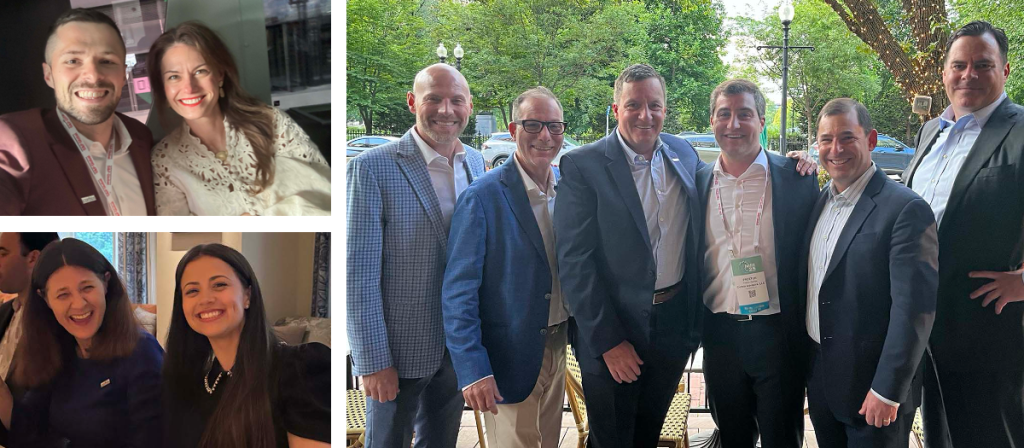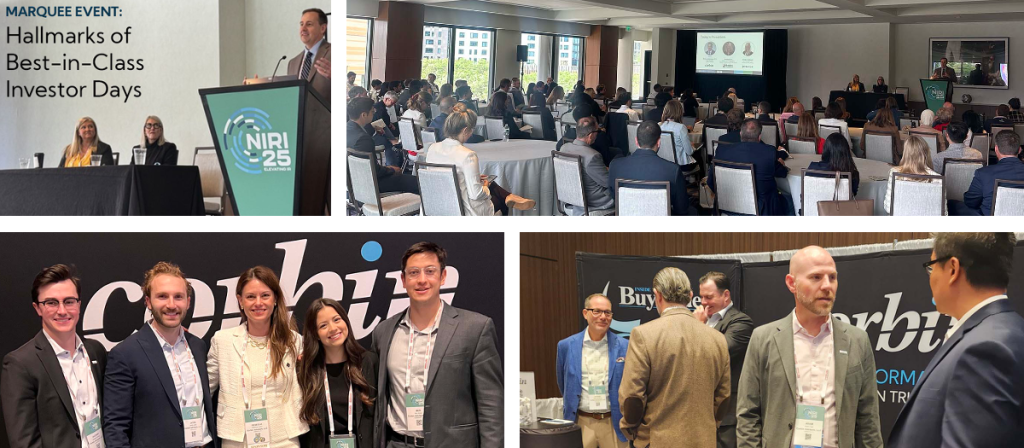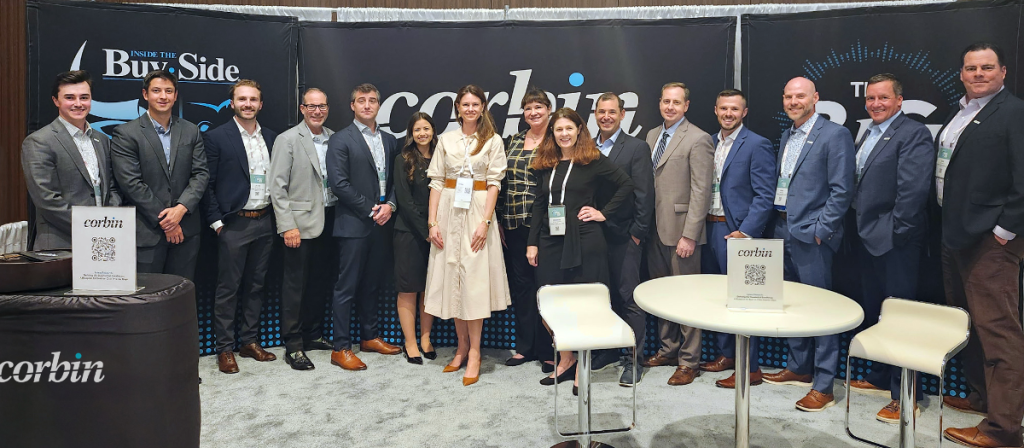NIRI 2025 Annual Conference Recap




We kicked off the Annual Conference with a standing-room-only session, presenting the findings from our latest, cutting-edge research, Defining the Standard of Excellence: A Blueprint for Best-in-Class Investor Days, where we moderated a dynamic panel featuring firsthand insights from seasoned IR leaders. As the opening presentation, the session sparked meaningful dialogue around Investor Day elements such as strategy, securing executive buy-in, structure and timing considerations, scenario analysis, and much more. A sincere thank you to Shelley Hubbard, Vice President of Investor Relations at Pentair, Heather Kos, Senior Vice President of Investor Relations at Builders FirstSource, and our own Rob Lockerman, a leader in Corbin’s Investor Day practice, for anchoring the conversation and elevating the discussion.
Three Key Themes from the National Investor Relations Institute Annual Conference
AI Remains Center Stage
The primary theme that echoed throughout the conference (and fueled some of the liveliest hallway buzz) was the accelerating role of AI in IR. From mainstage panels to express talks, sessions focused on showcasing AI’s growing utility for IROs of all experience levels, and it is clear the technology is flowing more practical than theoretical.
To that end, it’s important to note that adoption today falls along a wide spectrum. On one end, we’re seeing progressive tinkerers — teams piloting internal tools that streamline workflows, assist with content generation, and surface insights that professionals can build upon with judgment and context, what we call “human intelligence”. On the other end, even the more skeptical attendees showed healthy curiosity (every session was filled to the brim!), particularly around tactical use cases like transcript and press release drafting, Q&A prep, meeting note summarization, and enterprise search. These applications are still in early stages, and their effectiveness vary, but momentum is building. Notable technologies cited include Claude, ChatGPT, Gemini, and Notebook LLM, with service providers such as Irwin, AlphaSense, and Q4 unveiling/demoing new AI-enabled software at the conference.
Still, the elephant in the room loomed large: MNPI matters. Experts note that as experimentation grows, so does the need for disciplined data hygiene and secure, compliant frameworks. IR pros were strongly encouraged to proactively engage with IT and legal teams to ensure AI exploration happens within guardrails.
Some edge-case innovations added color to the conversation. Tone recognition tools, for instance, capable of detecting changes in pitch, pacing, and phrasing in executive remarks to reveal shifts in perceived confidence were noted as a burgeoning use case being incorporated by the investment community. As such, speakers underscored that today’s engagement is increasingly about tone and delivery, not just content.
Elsewhere, IR teams are beginning to build internal systems that integrate company documents, offering on-demand access to strategic information for content generation or quick analysis. Interestingly, several of these initiatives were being led by the IR function itself, but proving valuable across legal, strategy, and even board-level stakeholders.
ESG is being Quietly Reframed, Not Retired
While the ESG zeitgeist today remains a mystery owing in part to the current U.S. political climate and corporates avoiding getting spun up in the crosshairs, the themes underpinning it, particularly governance and the disclosure of financially material environmental and social risks, remain very much alive. The prevailing sentiment across sessions was clear: ESG is not going away, but simply being reframed in impactful, more strategic terms.
Governance, in particular, stood out as the anchor. Investors are looking for disciplined oversight, transparent succession planning, and clear accountability around how capital is being allocated and decisions are being made. In fact, strong governance is increasingly viewed not just as a risk mitigator, but as a competitive advantage.
On the environmental and social fronts, the call to action is to simplify and embed, not abandon. Corporations are being encouraged to tie ESG directly to business strategy, communicate materiality clearly, and ensure supporting materials (like ESG portals or one-pagers) are easily accessible and well-organized. In particular, speakers traced the evolution of ESG from what was initially seen as greenwashing to a more sophisticated emphasis on financial materiality. Investors today are less focused on the label and more interested in understanding which environmental and social factors directly influence performance and risk for a given company.
Of course, as our clients, this should not be an “aha” finding as we continually beat the drum of ESG pragmatism, specifically the critical importance of identifying materiality and grounding efforts in business risk mitigation and value optimization.
A few of the perspectives that stood out to us:
- ESG strategy “doesn’t need to be louder, but sharper”
- It’s about “translating values into value”
- Ensure that the information investors need is right at their fingertips, “without the noise”
As noted, we’ll be producing more on this topic in the coming months, so stay tuned!
The Best Deterrent to Activism is a Transparent Strategy
Activist investors were discussed throughout the conference, and IR professionals received a behind-the-scenes view of how some of the most prominent U.S. activists assess companies and identify opportunity. While sessions followed Chatham House Rules, the guidance shared underscored a central truth: when a company articulates a clear strategy and reinforces it consistently across communications, activists have less room to build a compelling case. Put simply, even if critics emerge, a well-informed and aligned shareholder base leaves little oxygen for alternative narratives to take hold.
While long embedded in the Corbin playbook, the discussion underscored Perception Studies as an underutilized yet powerful tool. When conducted on the bookends of key inflection points such as executive transitions, shifts in capital allocation, or portfolio realignments, they help surface early signs of misalignment between management and the Street. This insight, in turn, can sharpen messaging, guide engagement strategy, and elevate conversations with the board. But beyond corporate pivotal junctures, we believe Perception Studies serve as the necessary bloodwork and thus, should be part of a preventative maintenance and strength training program that supports companies’ healthy, antigen-free existence.
Several presenters echoed a sentiment we often share with clients: the best way to keep activists at bay is to “be your own best activist.” This means proactively identifying internal vulnerabilities before they become external talking points. It also means creating space for candid conversations across teams, addressing friction points head-on, and ensuring the company (not the investment community or media) controls the narrative. As one prominent activist panelist noted, foregoing an investor day for multiple years is a missed opportunity to realign the Street around refreshed financial targets and strategy, an opportunity activists are often quick to seize. And the survey says…your shareholders agree. According to our latest research, hosting an Investor Day every two years is the most preferred cadence across all market caps, favored by roughly half of surveyed investors, followed by 29% who prefer annual events and just 19% citing every three years.
In Closing
We hope our takeaways spark new ideas, thoughtful conversations, and perhaps a closer look at current efforts with an eye toward driving even greater efficiency and impact. As bold thinkers and master executors in building equity value for our clients, we’re here to help you unlock embedded potential.




